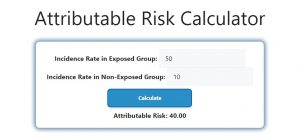About Attributable Risk Calculator (Formula)
The Attributable Risk (AR) Calculator is a vital tool in epidemiology and public health research. It helps determine the proportion of disease cases that can be attributed to a specific risk factor or exposure. Understanding attributable risk is essential for public health professionals, researchers, and policymakers to evaluate the impact of risk factors on health outcomes. This article will explain the formula used in the Attributable Risk Calculator, outline the steps to use it, provide a practical example, and answer frequently asked questions regarding this important concept.
Formula
The formula for calculating attributable risk is:
AR = Ie – Ine
Where:
- AR = Attributable Risk
- Ie = Incidence rate of disease in the exposed group
- Ine = Incidence rate of disease in the non-exposed group
How to Use
Using the Attributable Risk Calculator involves the following steps:
- Determine the Incidence Rate in the Exposed Group (Ie): This is the rate of the disease in the group that has been exposed to the risk factor.
- Determine the Incidence Rate in the Non-Exposed Group (Ine): This is the rate of the disease in the group that has not been exposed to the risk factor.
- Input the Values: Enter the incidence rates for both the exposed and non-exposed groups into the formula.
- Calculate Attributable Risk: Subtract the incidence rate of the non-exposed group from the incidence rate of the exposed group to find the attributable risk.
Example
Let’s consider a scenario where you are studying the relationship between smoking and lung cancer.
- Input Values:
- Incidence rate of lung cancer in smokers (Ie) = 50 cases per 1000 people
- Incidence rate of lung cancer in non-smokers (Ine) = 10 cases per 1000 people
- Apply the Formula: AR = Ie – Ine
AR = 50 – 10
AR = 40 cases per 1000 people
This means that there are 40 additional cases of lung cancer per 1000 smokers that can be attributed to smoking.

FAQs
- What is attributable risk?
Attributable risk is the difference in the incidence of disease between an exposed group and a non-exposed group, indicating the impact of the exposure. - Why is attributable risk important?
It helps quantify the public health impact of a risk factor and informs prevention strategies and health policy decisions. - What does a high attributable risk indicate?
A high attributable risk suggests that a significant portion of the disease cases in the exposed group can be linked to the risk factor. - Can attributable risk be negative?
No, attributable risk cannot be negative. It indicates the excess risk due to the exposure, so it will always be zero or positive. - How do I interpret the attributable risk value?
The value indicates the number of disease cases that can be attributed to a specific risk factor in a defined population. - What is the difference between attributable risk and relative risk?
Attributable risk quantifies the excess risk due to exposure, while relative risk compares the risk in exposed and non-exposed groups. - Can I use this calculator for any disease?
Yes, the Attributable Risk Calculator can be applied to any disease where exposure data is available. - What is the significance of using incidence rates?
Incidence rates provide a measure of how frequently new cases occur in a population, which is essential for accurate risk calculations. - How does sample size affect attributable risk calculations?
A larger sample size generally leads to more reliable estimates of incidence rates and attributable risk. - Are there limitations to the Attributable Risk Calculator?
Yes, it does not account for confounding variables or biases that may affect the observed relationship between exposure and disease. - How can I improve the accuracy of my incidence rates?
Use representative samples, ensure accurate diagnosis, and apply consistent definitions for disease and exposure. - Is attributable risk used in other fields besides public health?
Yes, it can also be used in fields like environmental health, occupational health, and clinical research. - How often should attributable risk be calculated?
It should be calculated whenever new data on exposures or diseases become available, especially after significant public health interventions. - Can attributable risk inform health policy?
Yes, understanding attributable risk can help prioritize public health initiatives and allocate resources effectively. - What data sources are best for calculating incidence rates?
Reliable data sources include health surveys, epidemiological studies, and government health statistics. - What if I only have prevalence data?
Attributable risk calculations ideally use incidence data, but you may use prevalence in conjunction with duration of disease for estimates. - How can I communicate attributable risk findings to the public?
Use clear and concise language, focusing on the implications for health behavior and policy. - Is there a software tool for calculating attributable risk?
Yes, various statistical software packages can perform these calculations, or you can use online calculators specifically designed for this purpose. - How does one ensure ethical considerations in reporting attributable risk?
Provide context for findings, avoid sensationalism, and communicate limitations clearly to maintain public trust. - Can this calculator help in determining preventive measures?
Yes, understanding attributable risk can guide targeted prevention strategies for high-risk populations.
Conclusion
The Attributable Risk Calculator is a crucial tool for assessing the impact of risk factors on disease incidence. By using the formula to calculate attributable risk, public health professionals can identify how much of the disease burden can be attributed to specific exposures. This information is vital for designing effective health interventions and informing policy decisions. Understanding and communicating the implications of attributable risk can help improve health outcomes and guide public health efforts towards preventing diseases associated with known risk factors.